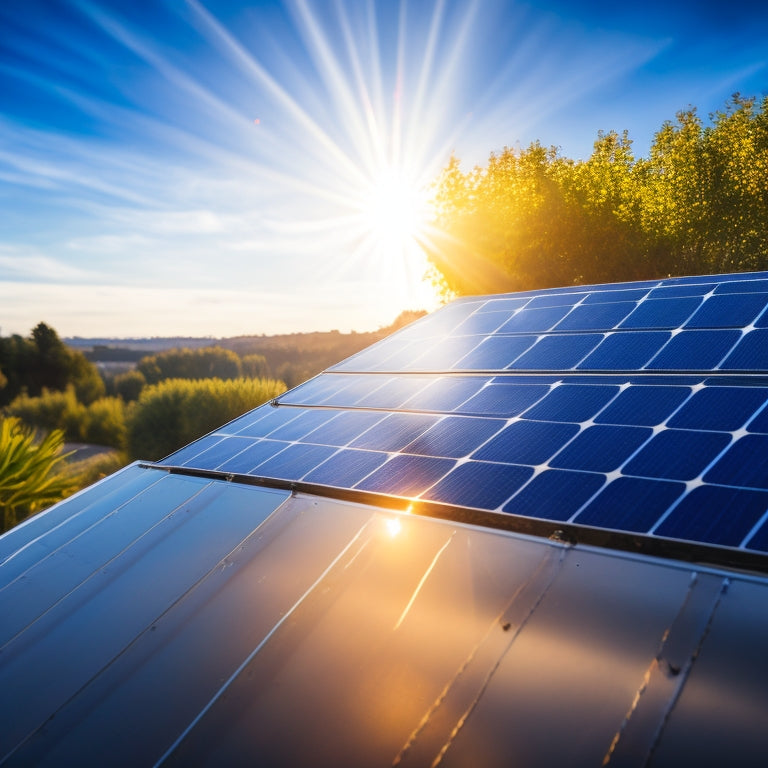
How Efficient Are Thin Film Solar Cells
Share
Thin film solar cells provide an innovative approach to energy generation, boasting efficiency rates generally between 10% to 12%, with some advanced materials achieving up to 20%. Their lightweight, flexible design enables installation in limited spaces where traditional panels might not fit, making them perfect for urban environments. Unique materials like CdTe and CIGS enhance light absorption, especially in low-light conditions, maximizing energy output. While their performance can vary based on environmental factors, their cost-effectiveness and adaptability position them as a significant player in renewable energy. Exploring their particular characteristics reveals even more opportunities for efficient energy solutions.
At a Glance
- Thin film solar cells feature high light absorption efficiency, enhancing energy conversion through improved light trapping capabilities of materials like CdTe and CIGS.
- They are lightweight and compact, allowing for easy installation in limited spaces, which maximizes energy generation potential without heavy structural requirements.
- Cost-effective manufacturing and abundant raw materials contribute to lower production costs, making renewable energy more accessible and economically viable for consumers.
- Performance can vary based on environmental factors; they excel in low-light conditions but may degrade under high temperatures, affecting overall efficiency.
- Innovations such as building-integrated photovoltaics and solar textiles expand their application potential, promoting seamless integration into various structures for enhanced energy solutions.
Space-Saving Design Advantages
Thin film solar cells offer compact installation options that maximize energy generation in limited spaces.
Their lightweight materials not only reduce structural load but also simplify mounting processes on various surfaces.
This innovative design allows you to integrate solar technology seamlessly into urban environments or unconventional locations, promoting energy independence and reducing reliance on fossil fuels.
Additionally, these cells can effectively meet daily energy demands, making them an attractive choice for homeowners looking to optimize their solar energy systems.
Compact Installation Options
The rise of compact installation options in solar technology has revolutionized how we approach energy generation in limited spaces.
You'll find that compact systems can be integrated seamlessly into urban environments, maximizing efficiency without sacrificing aesthetics. These innovative installation techniques allow you to utilize solar energy on rooftops, balconies, and even building facades where traditional panels may not fit.
By employing thin film solar cells, you can take advantage of their lightweight and flexible nature, enabling a broader range of applications. This adaptability is essential for those seeking to optimize their energy independence in confined areas.
You'll appreciate how these systems can be custom-fitted to various structures, ensuring that every square foot contributes to your renewable energy goals.
Furthermore, the compact design means less material waste during installation, promoting sustainability while addressing your energy needs.
With the ability to install these systems quickly and efficiently, you can reduce downtime and start generating your own power sooner.
Embracing these compact installation options enables you to redefine your relationship with energy, making it possible to live sustainably even in the most space-restricted environments.
Lightweight Material Benefits
Lightweight materials in solar technology greatly enhance space-saving design advantages, allowing you to maximize energy generation without overwhelming structural integrity.
Thin film solar cells employ durable materials that considerably reduce weight compared to traditional solar panels. This reduction means easier installation and the ability to mount panels on diverse surfaces, from rooftops to vehicles, without compromising their stability.
The innovative design of thin film technology also minimizes the environmental impact associated with solar energy systems. By using fewer resources in manufacturing and requiring less structural support, these lightweight solar cells promote a more sustainable approach to energy generation.
You can capture solar power in urban environments where space is limited, effectively changing underutilized areas into energy-generating assets.
Moreover, the flexibility of these materials allows for creative installation options that traditional panels struggle to achieve. Whether you're retrofitting existing structures or integrating solar into new designs, lightweight materials enable you to think outside the box.
Ultimately, embracing lightweight, durable materials in solar technology not only optimizes space but also aligns with a commitment to environmental stewardship, setting the stage for a more sustainable future.
Cost-Effective Energy Solution
When you consider thin film solar cells, you quickly notice their lower production costs, which can greatly enhance your return on investment.
Additionally, their lightweight nature leads to installation and maintenance savings that make them an attractive option for energy solutions.
As a result, these solar technologies can improve overall system efficiency and optimize energy storage capacity.
Lower Production Costs
Lower production costs make thin film solar cells an increasingly attractive option for energy generation. By exploiting scalable manufacturing techniques, you can greatly reduce the costs associated with producing solar panels. This scalability allows manufacturers to adapt their processes, increasing output without proportionally increasing expenses.
As demand for renewable energy surges, the ability to ramp up production efficiently directly impacts pricing, making these cells more accessible to consumers.
Additionally, raw material sourcing plays an essential role in lowering production costs. Thin film technologies often employ abundant and less expensive materials compared to traditional silicon-based solar cells. This means you're not only tapping into a more sustainable energy source but also benefiting from lower upfront costs.
The combination of these factors creates a persuasive case for choosing thin film solar cells in energy systems.
As you consider your options in renewable energy, remember that cost efficiency is key to long-term savings and energy independence. The advancements in thin film technology reflect a shift towards economically viable solutions that enable individuals and businesses alike to make use of the sun's power without breaking the bank.
Installation and Maintenance Savings
The advantages of thin film solar cells extend beyond production costs, encompassing significant savings in installation and maintenance. When you consider the installation techniques, thin film systems are often lighter and more flexible than traditional panels, allowing for easier integration into various structures. This means you can use less labor and time during the installation process, which translates into lower overall costs.
Moreover, the maintenance strategies for thin film solar cells are equally impressive. Their sturdy design often leads to reduced susceptibility to environmental factors, minimizing the need for frequent upkeep. With fewer components and a simplified structure, you can expect lower long-term maintenance expenses. This efficiency not only liberates your budget but also enhances the reliability of your energy solution.
In essence, thin film solar cells represent a cost-effective energy solution that prioritizes both installation and maintenance savings. By embracing these innovative technologies, you're not just investing in renewable energy; you're also gaining the freedom to allocate resources more effectively, ensuring a sustainable and economically viable future.
Unique Material Properties
When you investigate thin film solar cells, you'll notice their exceptional light absorption efficiency, which greatly improves energy conversion.
This technology contributes to energy independence and autonomy by minimizing grid dependence.
Their flexibility and lightweight design open new avenues for integration into diverse applications, from building materials to portable devices.
Understanding these unique material properties is essential for maximizing solar technology's potential in various environments.
Light Absorption Efficiency
Optimizing light absorption efficiency in thin film solar cells hinges on the unique material properties employed in their construction. The ability of these materials to enhance light trapping and broaden spectral response is essential for maximizing energy conversion. By utilizing innovative compounds like cadmium telluride (CdTe) or copper indium gallium selenide (CIGS), you can achieve significant improvements in capturing a wider range of wavelengths.
Here's a comparison of the light absorption efficiency for different materials:
| Material | Light Trapping Capability | Spectral Response Range |
|---|---|---|
| CdTe | High | 400 - 900 nm |
| CIGS | Very High | 300 - 1800 nm |
| Amorphous Si | Moderate | 400 - 800 nm |
Each of these materials offers distinct advantages regarding light absorption efficiency. For instance, CIGS' broad spectral response allows it to utilize energy effectively across varying light conditions, giving it an extraordinary edge in diverse environments. By leveraging these unique material properties, you can reveal the full potential of thin film solar technology, laying the groundwork for innovative energy solutions that promote freedom and sustainability.
Flexibility and Lightweight Design
Frequently, the flexibility and lightweight design of thin film solar cells provide significant advantages over traditional solar technologies. These unique material properties allow you to install solar panels in a variety of unconventional spaces, enhancing application versatility. Imagine integrating solar technology onto curved surfaces or portable devices, altering everyday items into energy-generating assets.
The lightweight nature of thin film cells means you can reduce structural support requirements, making installations simpler and more cost-effective. This is particularly useful in urban environments where rooftop space is limited.
You'll find that their flexibility doesn't just enhance functionality; it also contributes to aesthetic appeal. The sleek, unobtrusive design allows for seamless integration into structural environments, ensuring that beauty and sustainability go hand in hand.
Moreover, thin film technology opens doors to innovations like solar textiles and building-integrated photovoltaics, further expanding your options. With these cells, you're not just adopting a renewable energy source; you're embracing a lifestyle of freedom, creativity, and adaptability.
In a world where energy efficiency is paramount, the unique characteristics of thin film solar cells enable you to envision a sustainable future customized to your needs.
Selecting Based on Efficiency Ratings
When choosing thin film solar cells, you need to take into account efficiency comparison metrics to guarantee you're making an informed decision.
Additionally, evaluating the key considerations for selecting solar battery systems can provide understanding into how well these cells will integrate with energy storage solutions.
Real-world performance factors also play a vital role in determining how well a cell will function under varying conditions.
Efficiency Comparison Metrics
Evaluating efficiency comparison metrics is fundamental for selecting the most suitable thin film solar cells for specific applications. You should focus on performance metrics that reflect the true capabilities of these cells in energy conversion. Efficiency benchmarks play a significant role, allowing you to compare different technologies side by side.
Understanding technology advancements is essential; recent innovations might expand the limits of efficiency. When examining testing standards, ascertain they align with recognized protocols to assure the reliability of the data.
Analyzing the environmental impact of various solar cells will help you make informed decisions, as some materials may pose greater ecological challenges than others. Additionally, consider market trends that influence the availability and price of thin film technologies.
Lifespan evaluation shouldn't be overlooked; a cell that performs well initially may not maintain its efficiency over time. By integrating these metrics into your selection process, you enable yourself to make choices that align with both performance and your ethical values.
Ultimately, the right metrics lead to informed decisions that maximize energy output while minimizing adverse environmental effects.
Real-World Performance Factors
How do real-world conditions impact the efficiency ratings of thin film solar cells? When you consider performance variability, it's vital to recognize that environmental factors like temperature sensitivity and sunlight intensity can drastically alter energy yield.
Thin film technologies often exhibit superior performance in low-light conditions, but high temperatures can lead to increased degradation rates, undermining their long-term viability.
The manufacturing techniques behind these cells also play a significant role. Innovations in material science can enhance durability and efficiency, yet not all products on the market reflect these advancements. As a result, when you evaluate options for market adoption, consider how different brands address these factors.
Technological advancements are continuously shaping thin film solar cells, but knowing how environmental impact affects performance helps you make informed decisions. For example, a cell may boast high efficiency ratings under controlled conditions, but real-world performance can vary.
Consequently, always assess how these elements, including their degradation rates and temperature sensitivity, align with your energy needs and expectations. By understanding these variables, you can select the best thin film solar solution that connects with your pursuit of freedom through sustainable energy.
Higher Energy-To-Weight Ratio
When you consider thin film solar cells, the lightweight materials used greatly enhance their energy-to-weight ratio.
This advantage allows for easier integration into various applications, from portable devices to large-scale installations.
Lightweight Material Advantages
In the domain of solar technology, lightweight materials stand out due to their superior energy-to-weight ratio, offering significant advantages over traditional solar cells. These advantages become vital when you consider applications where weight is a limiting factor, like in aerospace or portable devices.
By utilizing thin film solar cells made from lightweight materials, you're not only enhancing energy efficiency but also mitigating durability concerns. Traditional cells can be bulky and fragile, while thin films provide flexibility and resilience, essential for maintaining performance under varying conditions.
Moreover, lightweight solar solutions contribute positively to the environmental impact of solar energy systems. With lower material usage, you reduce the carbon footprint associated with production and transport, aligning with an eco-conscious ethos.
This is important for those who value freedom, as it allows for more versatile installations—whether on rooftops, vehicles, or remote locations—without the burden of heavy infrastructure.
In this way, embracing lightweight materials in solar technology not only optimizes energy generation but also champions sustainability, allowing you to leverage the power of the sun without compromise.
Ultimately, it's about choosing solutions that strengthen your aspirations while being mindful of the planet.
Frequently Asked Questions
What Is the Lifespan of Thin Film Solar Cells?
The lifespan of thin film solar cells varies, typically ranging from 10 to 25 years. Durability factors like environmental stress and installation quality influence performance degradation, impacting their overall efficiency and longevity in energy production.
How Do Thin Film Solar Cells Compare to Traditional Solar Panels?
Imagine a rooftop covered with sleek thin film solar cells instead of bulky panels. In your efficiency comparison, you'll notice lower upfront costs, but traditional panels often yield higher energy output in cost analysis over time.
Are Thin Film Solar Cells Suitable for All Climates?
You'll find thin film solar cells suitable for various climates, but consider performance factors like temperature and humidity. Installation considerations are essential, as they influence efficiency and longevity, ensuring you maximize your energy independence effectively.
Can Thin Film Solar Cells Be Recycled?
Yes, thin film solar cells can be recycled through innovative recycling processes. You'll find these methods considerably reduce the environmental impact, allowing you to adopt sustainable energy solutions while promoting a greener future.
What Maintenance Do Thin Film Solar Cells Require?
Imagine you've just installed thin film solar cells on your roof. To maintain them, check for debris and clean regularly, considering installation tips and performance factors to guarantee maximum energy output and long-term efficiency.
Explore More
In conclusion, thin film solar cells offer extraordinary efficiency with an energy-to-weight ratio that can reach up to 200 watts per kilogram. This makes them an attractive option for applications where space and weight are essential, such as in aerospace and portable devices. By leveraging their unique material properties and cost-effectiveness, you can make informed decisions that align with both sustainability goals and budget constraints. Embracing these advancements in solar technology could greatly enhance your energy solutions.
Related Posts
-

Is This the Future of Alternative Energy Systems
Yes, alternative energy systems are shaping the future of energy. Innovations in solar and wind technologies are driv...
-

Solar Phone Chargers for Camping Essentials
Solar phone chargers are must-haves for your camping essentials, allowing you to stay connected while enjoying nature...
-

Designing a Green Roof for Maximum Energy Efficiency
Designing a green roof for maximum energy efficiency involves several key strategies. Start by selecting native, drou...


